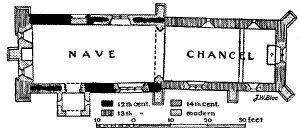ABOUT EXHALL PARISH COUNCIL
Exhall Parish Council aims to represent the interests of the residents of the parish as a whole and to preserve the environment for the enjoyment of the villagers, visitors and future generations. The Council is responsible for a range of services and also works in partnership with other councils and organisations in the village.
The Council is always keen to ensure that its priorities and initiatives reflect the wishes of the electorate: all meetings are open to the public and are preceded by a session for public comments. Alternatively, the clerk or individual councillors may be contacted if you have any ideas for or concerns about the parish, or any issues with which we may be able to help.
St. Giles Church
The parish church of ST. GILES is a small building with a nave dating from the 12th century, and a 13th-century chancel. It was much restored and in part rebuilt in 1862, mainly at the cost of the then rector.

[Plan of Exhall church]
The chancel (29½ ft. by 14½ ft.) leans a little to the south of the axial line of the nave. The east window is of two trefoiled lights and a quatrefoil in a two-centred head. It is of modern red sandstone outside and the internal splays, &c., are covered with Roman cement. In the north wall are two 13th-century lancets of grey Lias stone with segmental-pointed rear-arches. The two south windows are modern, the eastern of one light and the western of two lights and a quatrefoil. The east and north walls are of old Lias rubble, but the south has been rebuilt from a height of about 4½ ft. There are modern diagonal buttresses to the east angles and also one to the south wall. The chancel arch, of two chamfered orders, and the roof of the chancel, are modern. The nave (33½ ft. by 15½ ft.) has a modern north window of two lights and lattice tracery. (fn. 42) Farther west is a 12th-century doorway, now blocked. The jambs are recessed; the original nook-shafts are missing but their defaced capitals are in place, and have chamfered abaci, all of a sandstone: the round head is of two square orders, the inner of Cotswold stone, the outer of Lias stone. The blocking wall is hidden by an old plain nail-studded door, and there is no trace of the doorway internally. (fn. 43) In the south wall, near the east end, is an early-14th-century window of three trefoiled ogee-headed lights and foiled blanks in a square head. The outer order of the head and the segmental rear-arch are enriched with ball-flower ornament. The south doorway is modern. In the west wall are two single-light modern windows and between them inside a modern pointed doorway to a recess 3 ft. deep. The masonry of the north wall is of 12th-century Lias rubble west of the doorway but to the east it is of modern squared rubble, and there is a modern buttress between chancel and nave. The south wall east of the modern porch is also mainly of old Lias rubble, but west of the porch there is some old rubble in thin stones, perhaps of the 13th or 14th century. The west wall is 3 ft. 9 in. thick and has a modern middle buttress. The buttresses at the ends of the north and south walls are ancient although they have modern plinths and offsets. Both of them have an ancient batter on the west face about 2 ft. high above the plinth and extending along the wall to 6 or 7 ft. where the walling between them seems to have been rebuilt at some later medieval period. The gable-head, with its bell-turret, and the nave roof are modern. The font has a tapering round bowl on an octagonal stem; it is possibly an ancient bowl reworked but shows no signs of former staples for the lid. The other fittings are modern. In the chancel floor are small brass standing effigies of John Walsingham, died 20th January 1566, and Eleanor (Ashfield) his wife. (fn. 44) He is shown in Elizabethan armour and is incised on an irregularly rectangular plate, only silhouetted on his left side below the shoulder, possibly a palimpsest. She is in silhouette and wears a close cap, brocaded dress with padded sleeves, and a long cloak. Above the figures are two shields set upside down. The dexter charged with a trefoil between three molets (Ashfield); the sinister charged quarterly 1 (destroyed), 2 and 3, a checky cross between sixteen roundels, 4, paly of six a fesse (Walsingham).
From: 'Parishes: Exhall', A History of the County of Warwick: Volume 3: Barlichway hundred (1945), pp. 88-91. URL: Click Here. Date accessed: 25 November 2011.